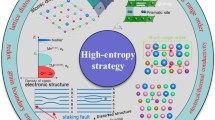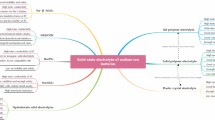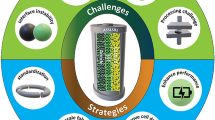Abstract
Anode materials are a key part of lithium-ion batteries, of which silicon-based anodes are considered the most promising electrode materials due to their high theoretical specific capacity. However, during the operation of the battery, the silicon material undergoes a huge volume change resulting in damage to the electrodes. Currently, the use of additive particles to make composite electrodes is a more reasonable approach. During the charge/discharge cycle of the battery, the electrodes may undergo cyclic expansion/contraction and may undergo elastic deformation and inelastic deformation, and lead to electrode ratchet deformation and capacity degradation. In this paper, a coupled nanoelectrode mechanics-electrochemistry model is developed to investigate the electrode stress evolution and strain accumulation of nanocomposite negative electrode during charge/discharge cycling under different influencing factors, and to analyze the change of electrochemical properties due to diffusion stress. Our work shows that the use of composite matrix materials, on the other hand, exhibits better mechanical stability, has smaller inelastic strains after a cycle, and produces less accumulation of irreversible strains. The established analytical model of nanocomposite electrode helps electrode design and is instructive for the preparation and structural design of nanocomposite negative electrodes.









Similar content being viewed by others
References
Viswanathan, V., Epstein, A.H., Chiang, Y.-M., Takeuchi, E., Bradley, M., Langford, J., Winter, M.: Author correction: the challenges and opportunities of battery-powered flight. Nature 603, E30–E30 (2022). https://doi.org/10.1038/s41586-022-04612-5
Meng, H., Geng, M., Xing, J., Zio, E.: A hybrid method for prognostics of lithium-ion batteries capacity considering regeneration phenomena. Energy 261, 125278 (2022). https://doi.org/10.1016/j.energy.2022.125278
Liu, J., Duan, Q., Qi, K., Liu, Y., Sun, J., Wang, Z., Wang, Q.: Capacity fading mechanisms and state of health prediction of commercial lithium-ion battery in total lifespan. J. Energy Storage 46, 103910 (2022). https://doi.org/10.1016/j.est.2021.103910
Kumar, R., Tokranov, A., Sheldon, B.W., Xiao, X., Huang, Z., Li, C., Mueller, T.: In situ and operando investigations of failure mechanisms of the solid electrolyte interphase on silicon electrodes. Acs. Energy Lett. 1, 689–697 (2016). https://doi.org/10.1021/acsenergylett.6b00284
Chakraborty, J., Please, C.P., Goriely, A., Chapman, S.J.: Combining mechanical and chemical effects in the deformation and failure of a cylindrical electrode particle in a Li-ion battery. Int. J. Solids Struct. 54, 66–81 (2015). https://doi.org/10.1016/j.ijsolstr.2014.11.006
Wen, J., Wei, Y., Cheng, Y.-T.: Stress evolution in elastic-plastic electrodes during electrochemical processes: a numerical method and its applications. J. Mech. Phys. Solids 116, 403–415 (2018). https://doi.org/10.1016/j.jmps.2018.04.006
Dong, Y., Li, J.: Oxide cathodes: functions, instabilities, self healing, and degradation mitigations. Chem. Rev. 123, 811–833 (2023). https://doi.org/10.1021/acs.chemrev.2c00251
Xue, W., Huang, M., Li, Y., Zhu, Y.G., Gao, R., Xiao, X., Zhang, W., Li, S., Xu, G., Yu, Y., Li, P., Lopez, J., Yu, D., Dong, Y., Fan, W., Shi, Z., Xiong, R., Sun, C.-J., Hwang, I., Lee, W.-K., Shao-Horn, Y., Johnson, J.A., Li, J.: Ultra-high-voltage Ni-rich layered cathodes in practical Li metal batteries enabled by a sulfonamide-based electrolyte. Nat. Energy 6, 495–505 (2021). https://doi.org/10.1038/s41560-021-00792-y
Li, H., Song, Y., Lu, B., Zhang, J.: Effects of stress dependent electrochemical reaction on voltage hysteresis of lithium ion batteries. Appl. Math. Mech.-Engl. Ed. 39, 1453–1464 (2018). https://doi.org/10.1007/s10483-018-2373-8
Xiong, R., Zhou, M., Li, L., Xu, J., Li, M., Yan, B., Li, D., Zhang, Y., Zhou, H.: Decoupled measurement and modeling of interface reaction kinetics of ion-intercalation battery electrodes. Energy Storage Mater 54, 836–844 (2023). https://doi.org/10.1016/j.ensm.2022.11.027
Wen, B., Deng, Z., Tsai, P.-C., Lebens-Higgins, Z.W., Piper, L.F.J., Ong, S.P., Chiang, Y.-M.: Ultrafast ion transport at a cathode–electrolyte interface and its strong dependence on salt solvation. Nat. Energy 5, 578–586 (2020). https://doi.org/10.1038/s41560-020-0647-0
Piper, D.M., Yersak, T.A., Lee, S.-H.: Effect of compressive stress on electrochemical performance of silicon anodes. J. Electrochem. Soc. 160, A77 (2012). https://doi.org/10.1149/2.064301jes
Xie, H., Han, B., Song, H., Li, X., Kang, Y., Zhang, Q.: In-situ measurements of electrochemical stress/strain fields and stress analysis during an electrochemical process. J. Mech. Phys. Solids 156, 104602 (2021). https://doi.org/10.1016/j.jmps.2021.104602
Lee, Y.K., Song, J., Park, J.: Multi-scale coupled mechanical-electrochemical modeling for study on stress generation and its impact on multi-layered electrodes in lithium-ion batteries. Electrochim. Acta 389, 138682 (2021). https://doi.org/10.1016/j.electacta.2021.138682
Gao, C., Guan, L., Shi, Y., Zhou, J., Cai, R.: An analytical multiscale modeling of a nanocomposite anode with graphene nanosheets for lithium-ion battery. Acta Mech. 233, 5265–5281 (2022). https://doi.org/10.1007/s00707-022-03379-0
Yin, J., Shao, X., Lu, B., Song, Y., Zhang, J.: Two-way coupled analysis of lithium diffusion and diffusion induced finite elastoplastic bending of bilayer electrodes in lithium-ion batteries. Appl. Math. Mech.-Engl. Ed. 39, 1567–1586 (2018). https://doi.org/10.1007/s10483-018-2386-6
Xu, C., Weng, L., Chen, B., Ji, L., Zhou, J., Cai, R., Lu, S.: Modeling of the ratcheting behavior in flexible electrodes during cyclic deformation. J. Power. Sources 446, 227353 (2020). https://doi.org/10.1016/j.jpowsour.2019.227353
Zhao, K., Pharr, M., Vlassak, J.J., Suo, Z.: Inelastic hosts as electrodes for high-capacity lithium-ion batteries. J. Appl. Phys. 109, 016110 (2011). https://doi.org/10.1063/1.3525990
Hao, F., Fang, D.: Reducing diffusion-induced stresses of electrode–collector bilayer in lithium-ion battery by pre-strain. J. Power. Sources 242, 415–420 (2013). https://doi.org/10.1016/j.jpowsour.2013.05.098
Yang, F.: Insertion-induced expansion of a thin film on a rigid substrate. J. Power. Sources 241, 146–149 (2013). https://doi.org/10.1016/j.jpowsour.2013.04.103
Yang, B., He, Y.-P., Irsa, J., Lundgren, C.A., Ratchford, J.B., Zhao, Y.-P.: Effects of composition-dependent modulus, finite concentration and boundary constraint on Li-ion diffusion and stresses in a bilayer Cu-coated Si nano-anode. J. Power. Sources 204, 168–176 (2012). https://doi.org/10.1016/j.jpowsour.2012.01.029
Wang, D., Wang, Y., Zou, Y., Lu, C., Ma, Z.: Anisotropic mechanical properties of Si anodes in a lithiation process of lithium-ion batteries. Acta Mech. 229, 3293–3303 (2018). https://doi.org/10.1007/s00707-018-2169-4
Zhao, K., Tritsaris, G.A., Pharr, M., Wang, W.L., Okeke, O., Suo, Z., Vlassak, J.J., Kaxiras, E.: Reactive flow in silicon electrodes assisted by the insertion of lithium. Nano Lett. 12, 4397–4403 (2012). https://doi.org/10.1021/nl302261w
Yang, F.: Generalized Butler-Volmer relation on a curved electrode surface under the action of stress. Sci. China Phys. Mech. Astron. 59, 114611 (2016). https://doi.org/10.1007/s11433-016-0198-6
Sethuraman, V.A., Srinivasan, V., Newman, J.: Analysis of electrochemical lithiation and delithiation kinetics in silicon. J. Electrochem. Soc. 160, A394 (2012). https://doi.org/10.1149/2.008303jes
Di Leo, C.V., Rejovitzky, E., Anand, L.: Diffusion–deformation theory for amorphous silicon anodes: the role of plastic deformation on electrochemical performance. Int. J. Solids Struct. 67–68, 283–296 (2015). https://doi.org/10.1016/j.ijsolstr.2015.04.028
Lu, Y., Zhang, P., Wang, F., Zhang, K., Zhao, X.: Reaction-diffusion-stress coupling model for Li-ion batteries: the role of surface effects on electrochemical performance. Electrochim. Acta 274, 359–369 (2018). https://doi.org/10.1016/j.electacta.2018.04.105
Liu, Y., Wu, H., Chen, G.: Enhanced mechanical properties of nanocomposites at low graphene content based on in situ ball milling. Polym Composite 37, 1190–1197 (2016). https://doi.org/10.1002/pc.23283
Wang, M., Xiao, X., Huang, X.: Study of lithium diffusivity in amorphous silicon via finite element analysis. J. Power. Sources 307, 77–85 (2016). https://doi.org/10.1016/j.jpowsour.2015.12.082
Song, Y., Shao, X., Guo, Z., Zhang, J.: Role of material properties and mechanical constraint on stress-assisted diffusion in plate electrodes of lithium ion batteries. J. Phys. D Appl. Phys. 46, 105307 (2013). https://doi.org/10.1088/0022-3727/46/10/105307
Lu, B., Song, Y., Zhang, Q., Pan, J., Cheng, Y.-T., Zhang, J.: Voltage hysteresis of lithium ion batteries caused by mechanical stress. Phys. Chem. Chem. Phys. 18, 4721–4727 (2016). https://doi.org/10.1039/C5CP06179B
Jiang, Y., Niu, Z., Offer, G., Xuan, J., Wang, H.: Insights into the role of silicon and graphite in the electrochemical performance of silicon/graphite blended electrodes with a multi-material porous electrode model. J. Electrochem. Soc. 169, 020568 (2022). https://doi.org/10.1149/1945-7111/ac5481
Sethuraman, V.A., Nguyen, A., Chon, M.J., Nadimpalli, S.P.V., Wang, H., Abraham, D.P., Bower, A.F., Shenoy, V.B., Guduru, P.R.: Stress evolution in composite silicon electrodes during lithiation/delithiation. J. Electrochem. Soc. 160, A739–A746 (2013). https://doi.org/10.1149/2.021306jes
Funding
This work was supported by the National Natural Science Foundation of China (10502025, 10872087, 11272143), the Program for Chinese New Century Excellent Talents in university (NCET-12-0712).
Author information
Authors and Affiliations
Corresponding author
Ethics declarations
Conflict of interest
The authors declare that they have no conflict of interest.
Additional information
Publisher's Note
Springer Nature remains neutral with regard to jurisdictional claims in published maps and institutional affiliations.
Appendices
Appendix A
In order to better characterize the degree of agglomeration of GNS in composites, the following two agglomeration parameters ζ and λ are introduced:
where \({\phi }_{a}\) is the volume fraction of the agglomeration domain,\({\phi }_{r}\) is the average volume fraction of GNS and \({\phi }_{r}^{a}\) is the volume fraction of GNS in the agglomeration domain.
The mechanical properties of the composites were calculated using the Mori–Tanaka method when the reinforced GNS is distributed in the matrix along a random direction, assuming that the effective modulus of the matrix and agglomerate domains is
Based on previous work,\({k}_{\alpha }=678{\text{GPa}}\),\({l}_{r}=245{\text{GPa}}, {m}_{r}={p}_{r}=368{\text{GPa}}\) and \({n}_{r}=1099{\text{GPa}}\) were selected.
For the effective modulus of the composite, it can be calculated
where \(\alpha =\frac{3{K}_{m}}{3{K}_{m}+4{G}_{m}}\) and \(\beta =\frac{6({K}_{m}+{G}_{m})}{5(3{K}_{m}+4{G}_{m})}\).
The elastic modulus of the composite is given by
Appendix B
For sheet-reinforced GNS, the modulus of elasticity along the length and width directions are described by the Halpin–Tsai equations, respectively, as
where E is the modulus of the composite material, and the subscripts l, w, 0, and s represent the longitudinal, transverse, initial matrix, and additives, respectively, \(\zeta\) is the geometric measurement parameter depending on the load condition, and the subscripts l and w represent the longitudinal and transverse direction, respectively. In the case of such a volume fraction, there is \(\zeta =2\frac{a}{b}\), in which a is the length along the force direction, b is the width in the cross-sectional direction.\(\upchi =\frac{{E}_{s}/{E}_{0}-1}{{E}_{s}/{E}_{0}+\zeta }\) is the composite modulus control factor which is related to the material properties of the initial matrix and the additive.\(\phi\) is the volume fraction of the additives. It should be noted that \(\phi\) here has the same meaning as \({\phi }_{r}\) in “Appendix A.”
Rights and permissions
Springer Nature or its licensor (e.g. a society or other partner) holds exclusive rights to this article under a publishing agreement with the author(s) or other rightsholder(s); author self-archiving of the accepted manuscript version of this article is solely governed by the terms of such publishing agreement and applicable law.
About this article
Cite this article
Liu, Z., Li, L., Liu, J. et al. Force-chemical coupling analysis of nanocomposite anode during charging and discharging process. Acta Mech (2024). https://doi.org/10.1007/s00707-024-03878-2
Received:
Revised:
Accepted:
Published:
DOI: https://doi.org/10.1007/s00707-024-03878-2




